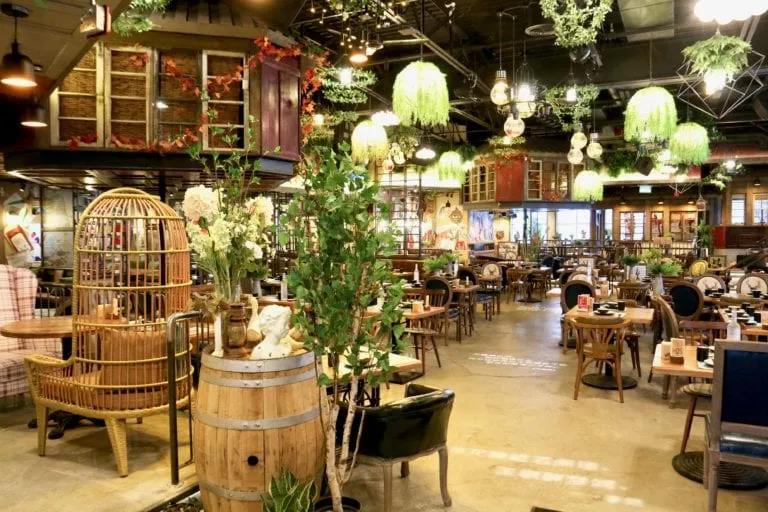The restaurant is set up like this, never afraid of vacancies!Today's headlines

If you often go to a restaurant, it is not difficult to find: in the restaurant, some tables and chairs are particularly popular with customers, but some are rarely touched, especially in a certain corner of a certain position. Although rarely used seats do not occupy the table area, they occupy the restaurant's operating area.
The seemingly inconspicuous placement of tables and chairs is actually quite knowledgeable. It is not only directly linked to the "face value", but also closely related to the restaurant's revenue.
ONE
The layout of tables and chairs determines the quality of the restaurant
The setting of tables and chairs is a facade of the restaurant. Most of the time, people will judge whether it is satisfying or not based on the hard decoration style of the restaurant, the so-called "choose by appearance". A glance at the distribution of tables and chairs in the store can tell you the quality and style of a store.
Some restaurants are equipped with a lot of tables and chairs, and the passenger flow does not match it. When the seats are empty, the guests will put luggage, bags, clothes, etc., which is a huge cost waste.
Therefore, if the customer source and production capacity of the entire restaurant cannot reach a certain level, the extra area would rather be empty than blindly filled with seats.

A restaurant with a clear positioning should allow customers to look at the decoration and seating settings in the store, and then they can feel the catering category and quality style of a store.
Just like cafes seldom use plastic tables and chairs in street restaurants, but mostly use wooden tables, chairs, leather sofas, etc., all because of the different positioning of products and restaurants.
TWO
Reasonable number of seats can increase turnover
Restaurant efficiency does not lie in the number of seats, but in the effective utilization of seats.
Business dinners, gatherings of friends, and couples’ dates have different needs for tables. The number and ratio of tables and chairs at the beginning of a restaurant design actually rejected some people from entering the store to a certain extent.

The restaurant in the above picture is an example. This shop has more than 400 square meters, with an annual rent of more than 2 million, and about 120 seats. It does not mean that the number of tables designed during the decoration will generate a corresponding amount of turnover.
Fast food is called seat efficiency, and dinner is called table efficiency.
After a period of data analysis in Lugang Town, it is found that the proportion of 2-3 persons per order is relatively high, accounting for 65%, and 4-5 persons accounting for 24%. Then they adjusted the ratio of tables and chairs, and the ratio of 4-person tables to 2-person tables was increased. The final area is the same, and the number of seats has increased.
After the increase, the turnover rate will drop, but it does not matter, the final turnover is increased, because the efficiency of the use of each table is improved.
On average, the turnover is 1.56 million (previously 1.48 million), so the rent accounted for less, which means that the floor efficiency is higher.
THREE
How to design a high-utilization table combination
Taking the data of a Chinese restaurant as an example, 62% of the customers dining with 2 people, 31% of the customers dining with 4 people, and 7% of the customers dining with 6 people.
Please note that restaurants rarely use odd-numbered dining tables, and most of the number of diners is marked with an even number. For example, a meal for 3 people is counted as a dining customer for 4 people, and a meal for 5 people is counted as a dining group for 6 people.

From the above calculations, the average number of people in the restaurant combination is 2.9, and the number of tables that the restaurant should set up is 20.68. By conversion, the optimal combination of seats in her restaurant should be:
12.82 sheets for 2 persons, 6.41 sheets for 4 persons, 1.44 sheets for 6 persons
Only in this way can more customers be served and the restaurant's revenue can be maximized under the same time period and passenger flow.
The methodology is already known, so what do the restaurants need to do in daily operations?
1. Record the combined data of the number of diners
For restaurants with a certain degree of operating experience, the order cashier system and queuing software can record the combination of the number of people dining. In addition to the recording data of related software, restaurants should also consciously focus on recording.
2. Use flexible seating combinations
In the first-tier cities and Hong Kong and Macao regions where the land and the money are high, many restaurants not only maximize the use of space, but also make flexible combinations in the table design to increase the utilization rate of the table.
These restaurant tables are mostly two-person tables. When two people dine, they will not waste a table. For four-person dining, two two-person tables are put together with a large tablecloth. If six people dine together, add it to the joint table. A round turntable ensures that customers at each table will pick up dishes. Such efficient and flexible use of dining space has a good reference significance.
3. Give new value to low-value seats
Windows, private rooms, and walls are areas where consumers prefer consumers. Conversely, areas such as aisles, toilets, and stairways are areas where consumers are more resistant. This is a customer psychology determined by the "geographical" nature of the seat. It is difficult to reverse it directly.
So how can we eliminate the resistance of diners and increase the load factor? It is not difficult to give consumers a "reason" for choosing to sit there.
The restaurant can be set up with a creative background wall that can be used for selfies, and can be landscaped to form a theme to guide consumers to "gather" and sit together.
Restaurant customers are dynamic, and different consumption scenarios (such as holidays, time periods, consumer groups) will give rise to different demand for seats. Only when restaurants always pay attention to customer dynamics can they respond to changing needs with flexible and multi-form hardware.
免责声明:1.餐饮界遵循行业规范,转载的稿件都会明确标注作者和来源;2.餐饮界的原创文章,请转载时务必注明文章作者和"来源:餐饮界www.canyinj.com",不尊重原创的行为餐饮界或将追究责任;3.投稿请加小编微信toutiaoxiansheng或QQ1499596415。4.餐饮界提供的资料部分来源网络,仅供用户免费查阅,但我们无法确保信息的完整性、即时性和有效性,若网站在使用过程中产生的侵权、延误、不准确、错误和遗漏等问题,请及时联系处理,我们不承担任何责任。
 扫码关注餐饮界微信号
扫码关注餐饮界微信号
- How to create 10W+ burst arti
- Douyin Group buys PK Meituan,
- The restaurant has employees a
- The 4 major business logic beh
- Tudou Group joins hands with t
- Wooden house barbecue stopped
- Haidilao's 2020 earnings repor
- That little shop on the corner
- Meals and drinks: one to the e
- What is the difference between


 Media
Media


